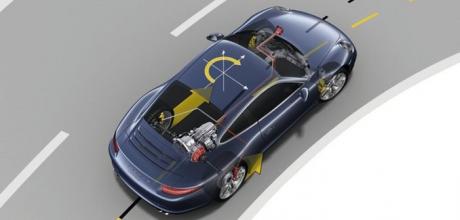Technology explained Porsche Torque Vectoring

Discover how the Porsche Torque Vectoring system helps to keep your 911 on the road.
The driving characteristics of the 911 are well known, if something of a dichotomy. The rear-engined layout permits immense traction out of corners, but at the same time the car is ever-ready to punish driving with less-than-perfect technique. Carry too much speed into a corner, lift off and you have all the ingredients of the classic 911 accident for the inexperienced. On the other hand, experienced drivers are able to exploit the rear-engined design, using the weight to help rotate the car around a bend.
This is all well and good, and while we can spend hours on the track finessing our driving techniques, Porsche has come up with a technological aid to tackle the issue of cornering at speed: Porsche Torque Vectoring (PTV). First launched on the 997 Turbo in 2009, PTV is designed to support Porsche Stability Management (PSM) and the all-wheel-drive system. While PSM is largely about traction and lateral stability, PTV has a different role – that of cornering.
There are two elements to PTV: a mechanical rear axle differential lock; and brake-operated variable torque distribution on the rear axle, locking 22 per cent under power and 27 per cent on overrun. PDK-equipped 911s benefit from PTV plus: an electronically controlled, totally variable differential lock along with the same brake-operated variable torque distribution.
When driving into a corner, PTV works by applying a braking force to the inside rear wheel. This light application of the brake then gives the outer rear wheel greater power and torque, therefore encouraging the vehicle to yaw – or twist – around the bend. It also gives more precise steering feel because the vehicle now wants to rotate into the radius, and corrects any understeer characteristics on the limit of grip, thanks to that inside wheel being braked.
Corner exit also benefits from PTV because of the locking differential, whether manual or electronic. Particularly helpful in lower traction situations, the differential helps both rear wheels maintain optimum rotation, regardless of surface, rather than the wheel with the least traction spin-out.
The result is the ability to corner at higher speeds with increased steering precision. It’s Porsche’s post-millennium solution to the traditional 911 skill of backing off the throttle to encourage mid-corner rotation.
Note that unlike PSM, which can be switched off by any driver who wants to cut down on automatic interventions, PTV is an active system. Because its function is that of aiding the 911’s dynamic behaviour and agility, PTV is constantly on.

